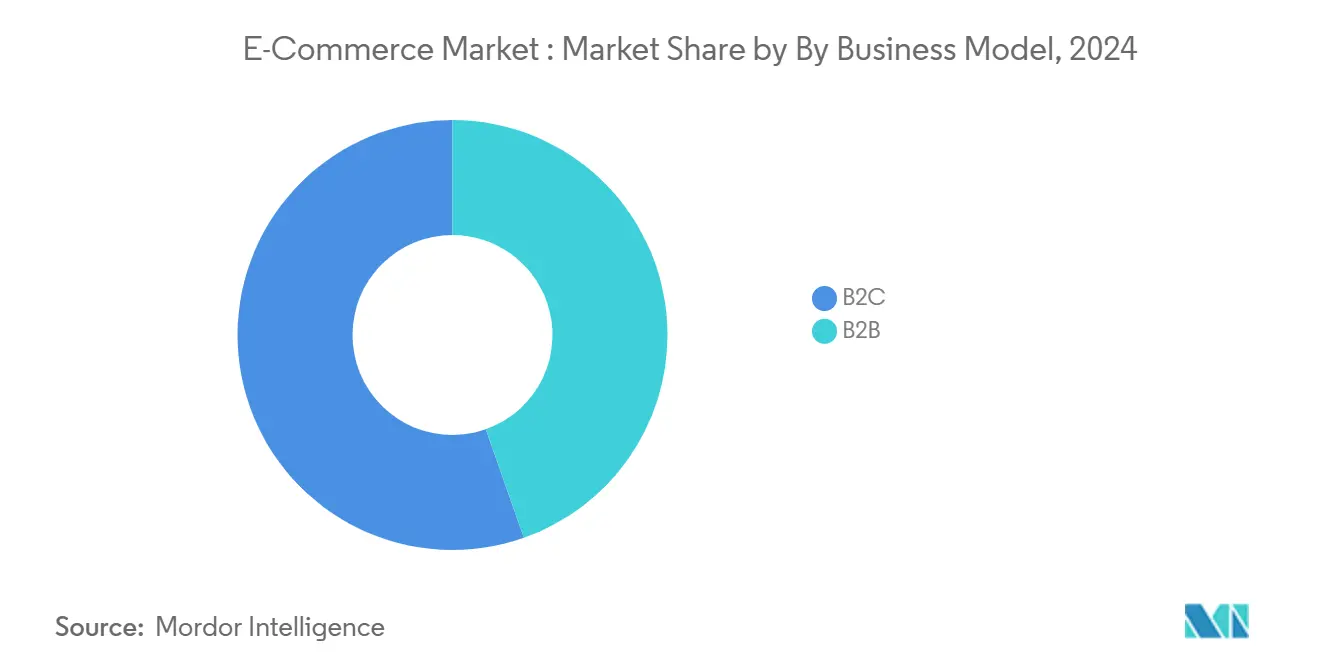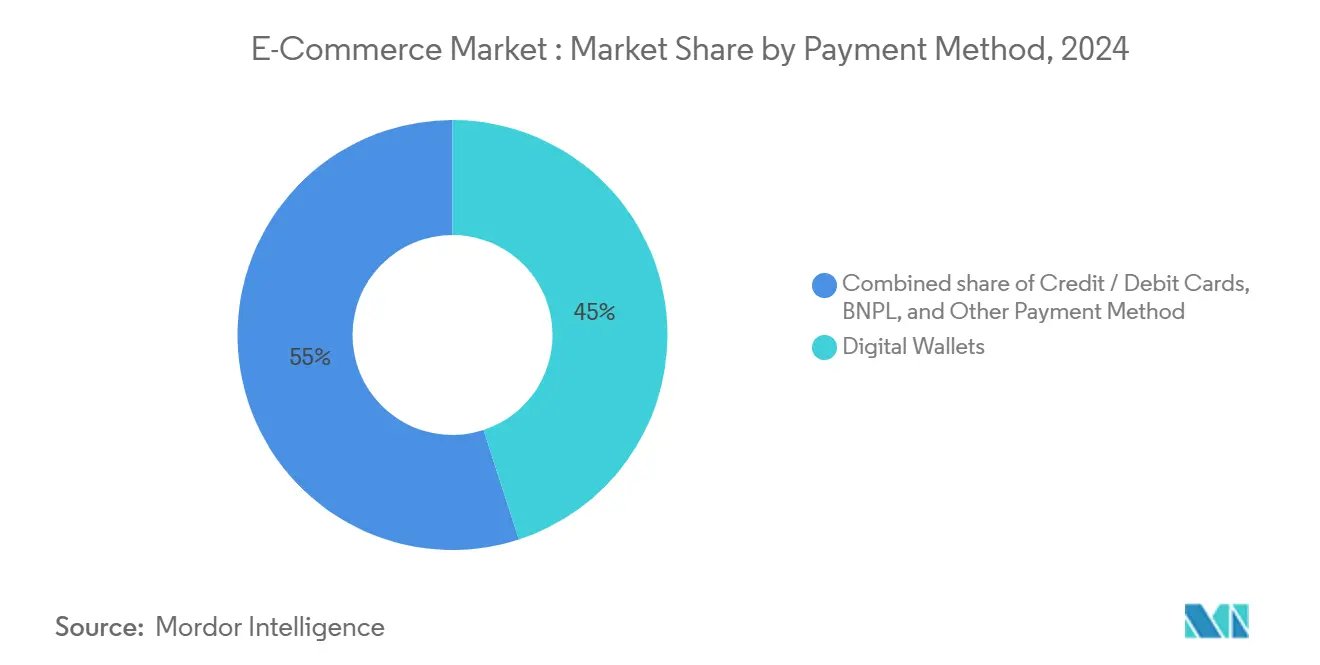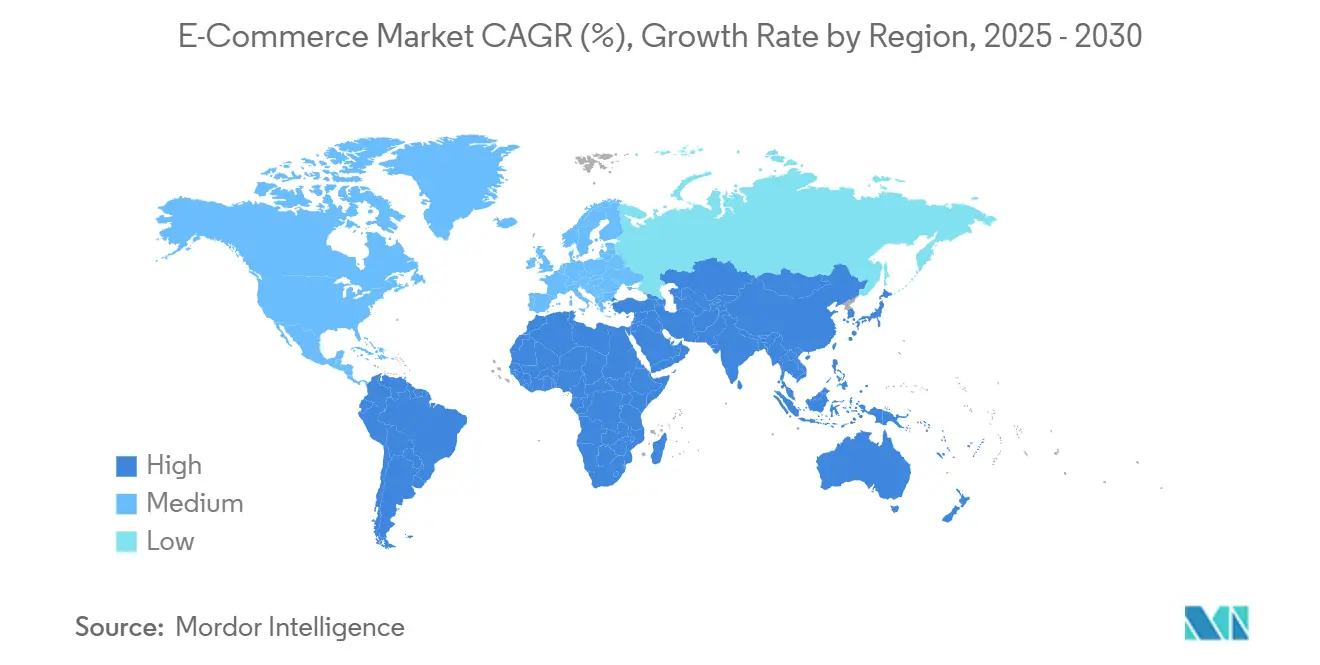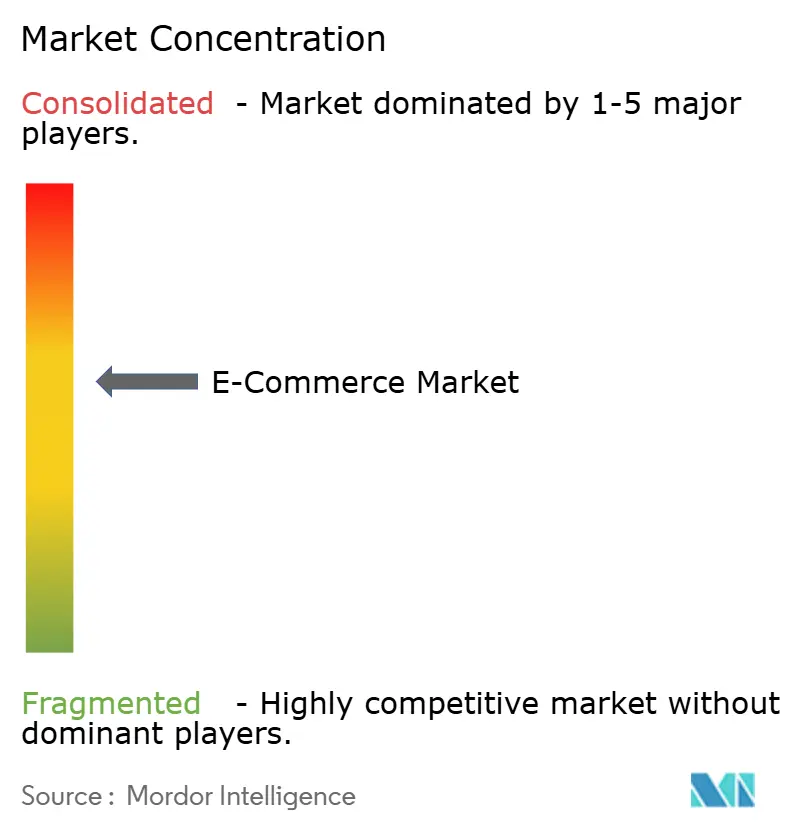
E-Commerce Market Analysis by Mordor Intelligence
The E-Commerce Market size is estimated at USD 31.22 trillion in 2025, and is expected to reach USD 73.47 trillion by 2030, at a CAGR of 18.67% during the forecast period (2025-2030).
This signals the channel’s evolution from digital alternative to primary retail infrastructure. The market continues to widen its lead over store-based retail thanks to mobile-first networks, embedded financial services, and artificial-intelligence-driven personalization that together shape how 5.16 billion internet users buy products and services. Asia-Pacific retains scale leadership, South America delivers pace leadership, and new consumer cohorts in Middle East and Africa close infrastructure gaps faster than any prior cycle. Competitive advantage now rests on orchestrating payment, logistics, content, and data into single ecosystems that reduce shopper friction at every step. Allied to that shift, sustainability regulation and cyber-risk enlarge operating complexity but accelerate technology adoption in fraud analytics, tax automation, and green delivery.
Key Report Takeaways
- By business model, the B2C segment held 55.4% revenue share in 2024; B2B is projected to advance at 19.3% CAGR through 2030.
- By device, mobile commanded 73% share of the 2024 e-commerce market size and is forecast to grow at 20.4% CAGR to 2030.
- By payment method, Buy Now Pay Later accounted for 21% of US online shoppers in 2024 and is on course for 23.6% CAGR to USD 576 billion transaction value in 2025.
- By B2C category, consumer electronics contributed 28% of the 2024 e-commerce market size; food and beverages is rising fastest at 23.5% CAGR.
- By geography, Asia-Pacific led with 55.2% of 2024 e-commerce market share, while South America is expected to expand at 20.5% CAGR to 2030.
Global E-Commerce Market Trends and Insights
Drivers Impact Analysis
| Driver | (~) % Impact on CAGR Forecast | Geographic Relevance | Impact Timeline |
|---|---|---|---|
| Accelerating Mobile-Internet & 5G Adoption | +4.2% | Global, with APAC leading at 1.9B 5G subscriptions by 2024 | Medium term (2-4 years) |
| Rising Middle-Class Purchasing Power | +3.8% | APAC core, spill-over to Latin America and MEA | Long term (≥ 4 years) |
| Expansion of Digital Wallets & Embedded Finance | +3.1% | Global, with 79% of banks predicting deep integration | Short term (≤ 2 years) |
| Generative-AI-Powered Personalised Merchandising | +2.9% | North America & EU early adoption, APAC scaling | Medium term (2-4 years) |
| Direct-to-Avatar & Virtual Goods Commerce Boom | +1.7% | Global, with Gen Z leading adoption | Long term (≥ 4 years) |
| Source: Mordor Intelligence | |||
Accelerating Mobile-Internet & 5G Adoption
5G coverage reduces transaction latency below 100 milliseconds, unlocking real-time augmented-reality product try-ons and livestream shopping that blend entertainment with checkout. Indonesia’s USD 73 billion e-commerce turnover in 2023 and 69% livestream engagement rate show how bandwidth scale, video culture, and mobile payment ubiquity amplify conversion.1ECDB, “eCommerce in Indonesia: Revenues & Market Development,” ecdb.com Mobile-optimised sites post 62% higher conversion than desktop, yet the structural leap is edge-computing support for AI image search that turns smartphones into primary discovery devices.2GO-Globe, “Mobile vs Desktop Usage: Trends, Stats, and Future Insights,” go-globe.com As 1.9 billion 5G subscriptions arrive by end-2024, mobile commerce is positioned to capture 79.4% of smartphone users by 2025, changing logistics design toward micro-fulfilment close to urban demand centers.
Rising Middle-Class Purchasing Power
Asia will add 1.47 billion middle-class consumers between 2020 and 2030, a redistribution of discretionary income that lifts premium digital categories. China’s service consumption grew 6.2% in 2024 and GDP per capita nears USD 15,000, driving a tilt toward experience-led online spending.3National Bureau of Statistics of China, “中华人民共和国2024年国民经济和社会发展统计公报,” stats.gov.cn Latin America mirrors the pattern, almost doubling e-commerce turnover from USD 125 billion in 2022 to USD 243 billion by 2027 as smartphone penetration exceeds 60%. Platforms address this demand by extending product mix to premium groceries, eco-friendly goods, and interest-free instalments.
Expansion of Digital Wallets & Embedded Finance
In the e-commerce market, Digital wallets hold 45% share of online checkouts and are gateways to broader embedded-finance suites that blend payments, instant credit, and tax calculation into one API call. Banks expect 79% of their services to run inside commerce flows by 2030.4Get Defacto, “Embedded Credit 2025: 9 Stats Signaling the Next Fintech Focus,” getdefacto.com China’s alternative payment share already sits at 65.9%, illustrating wallet ecosystems that increase customer lifetime value and compress acquisition cost. Embedded lending at checkout supports real-time underwriting for small merchants, while automated compliance shields cross-border transactions from jurisdictional errors.
Generative-AI-Powered Personalised Merchandising
Generative AI raises revenue 10-12% and lifts satisfaction more than 25% by tailoring imagery, copy, and product bundles for each shopper. Amazon’s recommendation algorithms demonstrate how cohort signals boost average order value and reduce bounce. The rise of agentic AI now allows on-the-fly catalogue creation and predictive inventory placement. Merchants applying AI report 3-15% revenue upticks alongside lower stock-out incidents because models match demand curves in near real time.
Restraints Impact Analysis
| Restraint | (~) % Impact on CAGR Forecast | Geographic Relevance | Impact Timeline |
|---|---|---|---|
| Escalating Cyber-Security & Fraud Risks | -2.8% | Global, with US merchants losing USD 4.61 per USD 1 fraud | Short term (≤ 2 years) |
| Cross-Border Regulatory & Tax Complexity | -2.1% | Global, particularly EU-US-APAC corridors | Medium term (2-4 years) |
| Sustainability-Linked Delivery Surcharges | -1.4% | EU and North America leading, APAC following | Long term (≥ 4 years) |
| Cookie-Deprecation Disrupting Ad Targeting | -1.2% | Global, with EU GDPR and US state privacy laws | Short term (≤ 2 years) |
| Source: Mordor Intelligence | |||
Escalating Cyber-Security & Fraud Risks
Fraud losses cost merchants USD 4.61 for every USD 1 lost transaction, up 32% versus 2022, with synthetic identities exploiting mobile wallets and QR codes. AI-driven anomaly detection and biometric authentication temper attack vectors but raise checkout friction, risking cart abandonment. Retailers now budget higher for device-fingerprint solutions and consortium data feeds, converting fraud management from cost center to competitive differentiator where approval rates become part of CX scorecards.
Cross-Border Regulatory & Tax Complexity
In the e-commerce market, Nineteen percent of merchants list cross-border tax as their single largest operational hurdle because every jurisdiction adds unique VAT thresholds, origin rules, and real-time reporting mandates. Marketplace-facilitator laws shift liability to platforms, prompting investments in cloud-native tax engines and customs pre-clearance integration. Complexity skews advantage to larger platforms with compliance resources, indirectly raising acquisition multiples for niche cross-border enablers.
Segment Analysis
By Business Model: Enterprise Digitisation Fuels B2B Momentum
B2C accounted for 55.4% of 2024 sales, yet B2B revenue is increasing at 19.3% CAGR, signalling a power shift that will recast e-commerce market dynamics over the decade. Asian suppliers already capture 80% of B2B flows as trade hubs digitise procurement workflows. The e-commerce market size for B2B transactions is on track to exceed USD 36 trillion by 2026, with industrial and healthcare buyers demanding catalog integration, credit terms, and punch-out connectivity.
B2B platforms mimic consumer playbooks—personalised recommendations, live chat, and embedded finance—but layer features like request-for-quote and contract pricing. As millennial procurement leads normalise web purchasing, long-tail suppliers accelerate onboarding, boosting assortment depth. Integrations with ERP software and AI demand forecasts tighten inventory turns, positioning B2B marketplaces as risk-sharing nodes inside global supply chains.

Note: Segment shares of all individual segments available upon report purchase
By Device Type: Mobile Networks Redefine Shopper Touchpoints
Mobile captured 73% of 2024 orders and will expand faster than any other interface at 20.4% CAGR, confirming the e-commerce market as mobile-first. Edge-served imagery, wallet-native checkout, and one-click returns turn smartphones into full-funnel tools from discovery through fulfilment. Desktop remains relevant for bulk B2B requisitions and high-consideration electronics, yet its share inches lower each year.
Other endpoints—smart TVs, voice assistants, wearables—add incremental transaction surface. Seventy-six percent of shoppers begin on one device and finish on another, forcing merchants to synchronise baskets and payments across sessions. Superior mobile time-to-interactive metrics correlate with 8% conversion lift, prompting legacy brands to re-platform storefronts around progressive web app standards.
By Payment Method: BNPL Reshapes Consumer Credit Economics
BNPL loan value is forecast to 23.6% CAGR that disrupts cards and store finance. Soft checks and zero-interest instalments resonate with sub-prime and Gen Z shoppers, raising average ticket size by 30% in fashion and electronics. Digital wallets still hold 45% share, but growth moderates as wallet features saturate.
Regulators now subject BNPL to Truth in Lending Act oversight after heavy-user counts hit 9.5 loans annually. Providers respond with income verification APIs and spending caps that protect margins. Embedded credit in merchant apps reveals the next battleground, where lenders price risk dynamically at SKU level, embedding underwriting as invisible step in user journey.

Note: Segment shares of all individual segments available upon report purchase
By B2C Product Category: Food & Beverages Capture Structural Tailwinds
Electronics retained a 28% slice of 2024 turnover, yet food and beverages clock the highest 23.5% CAGR, signalling permanent adoption of online groceries. Cold-chain logistics investment, dark-store networks, and 15-minute delivery services reposition fresh produce online as convenience rather than contingency.
Quick-commerce uses micro-fulfilment to serve urban cores and monetises high-frequency snack baskets. Beauty and personal care convert sampling into subscription boxes while fashion battles return costs with virtual try-on and fit-prediction engines. Furniture and DIY categories lag due to bulky-item logistics but gain momentum from augmented-reality room planning that shortens design cycles.
Geography Analysis
Asia-Pacific accounts for 55.2% of 2024 turnover in the e-commerce market, fed by China’s YUAN 15.2 trillion (USD 2.1 trillion) online sales and dense digital-wallet coverage. Indonesia’s market will scale from USD 73 billion in 2023 to USD 204 billion by 2028, with livestream and social checkout propelling SKU discovery. India adds double-digit growth on rising broadband affordability and UPI payment ubiquity, while Japan and Korea use near-perfect logistics reliability to drive premium category penetration. Government funding for rural broadband under China’s 14th five-year plan ensures depth as well as breadth in regional adoption.
South America delivers the strongest CAGR at 20.5% to 2030. Brazil’s USD 40 billion processing volume anchors the region, while Argentina’s 248% first-half 2024 sales spike highlights price-sensitive users finding inflation hedges online. Mobile commerce already represents 60% of digital spend and will hit 70% by 2026 as local wallets displace cash on delivery. Payment orchestration startups thrive in fragmented banking landscapes by routing cards, vouchers, and instalment plans through one API, lowering checkout abandonment for international sellers.
North America and Europe remain high-value markets with slower unit growth in the e-commerce market. Forty-two percent of US shoppers expect to expand online spend in 2025, yet penetration plateaus in affluent suburbs where omnichannel dominates. Europe tackles cross-border VAT alignment and stricter sustainability mandates that raise parcel costs but enhance consumer trust. Middle East and Africa present later-stage upside, with UAE and South Africa demonstrating mobile-first pathways that sidestep legacy retail formats.

Competitive Landscape
Twenty-three major platforms share a fragmented but dynamically concentrating arena the e-commerce market. Amazon holds 37.6% of US online retail yet confronts TikTok Shop, whose Southeast Asian gross merchandise value reached USD 22.6 billion in 2024 and whose US sales exceed USD 1 billion monthly. Success now hinges on blending media, payments, and fulfillment into sticky ecosystems. Alibaba posted RMB 280,154 million (USD 38,381 million) Q4 2024 revenue, reflecting 8% growth after shortening decision cycles through six semi-autonomous business groups that localize innovation. Shopify powers 2 million merchants and extends lifetime value with bank-as-a-service modules, illustrating how embedded finance levels scale advantages.
Regional champions reinforce relevance. MercadoLibre leverages MercadoPago to underwrite consumer credit in Brazil within seconds, delivering 20 point conversion lift. Sea Ltd.’s Shopee applies data from gaming subsidiary Garena to refine cross-sell algorithms in Indonesia. TikTok’s April 2025 re-organisation shifted Latin America leadership to Singapore teams to align go-to-market playbooks with Southeast Asian learnings, a move that trims latency in decision making and compliance.
Strategic patterns prioritise vertical integration in the e-commerce market. Logistics arms build same-day reach, in-house payment rails cut interchange, and first-party data fuels retail-media businesses that already command double-digit margin. AI deployment targets fraud detection, demand forecasting, and image generation for listings, moving competitive levers away from assortment breadth and toward operating-system efficiency. Platforms unable to fund such adjacencies face margin compression and potential relegation to niche specialist status.
E-Commerce Industry Leaders
-
Amazon.com Inc.
-
Alibaba Group Holding Limited
-
Walmart Inc.
-
JD.com Inc.
-
eBay Inc.
- *Disclaimer: Major Players sorted in no particular order

Recent Industry Developments
- June 2025: TikTok Shop completed restructuring of global e-commerce division, transferring authority from US managers to Chinese and Singaporean leaders ahead of Brazil market launch, targeting Latin America’s projected USD 250 billion e-commerce market by 2028.
- May 2025: Huawei eKit launched its first overseas e-commerce store on Shopee through a three-way partnership with Thai distributor AIOT, bringing network hardware to Southeast Asian SMEs with 24/7 virtual support and local warehousing.
- April 2025: South Korean grocery specialist Kurly formed a strategic alliance with Naver to integrate Naver Pay and live-commerce features, strengthening Kurly’s unit economics while giving Naver deeper grocery assortment for its shopping channel.
- March 2025: Mastercard partnered with Finnish PSP Paytrail to roll out Click-to-Pay across Finland, streamlining tokenised card payments for 20,000 local web shops and positioning Mastercard to capture wallet share as European PSD3 rules tighten security.
Research Methodology Framework and Report Scope
Market Definitions and Key Coverage
Our study defines the global e-commerce market as the total value of goods and services purchased through internet-enabled transactions across business-to-consumer, business-to-business, and consumer-to-consumer models, measured at the point of payment authorization and converted to constant 2025 USD. Digital orders placed via websites, mobile apps, social-commerce feeds, voice assistants, and embedded APIs are captured, while subsequent logistics or payment-processing revenues are not.
Scope Exclusions: Gift card breakage, in-store "click-and-collect" payments settled offline, and the gross value of online advertising are excluded.
Segmentation Overview
- By Business Model
- B2C
- B2B
- By Device Type
- Smartphone / Mobile
- Desktop and Laptop
- Other Device Types
- By Payment Method
- Credit / Debit Cards
- Digital Wallets
- BNPL
- Other Payment Method
- By B2C Product Category
- Beauty and Personal Care
- Consumer Electronics
- Fashion and Apparel
- Food and Beverages
- Furniture and Home
- Toys, DIY and Media
- Other Product Categories
- By Geography
- North America
- United States
- Canada
- Mexico
- Europe
- Germany
- United Kingdom
- France
- Spain
- Italy
- Netherlands
- Russia
- Rest of Europe
- Asia-Pacific
- China
- Japan
- India
- South Korea
- Indonesia
- Thailand
- Malaysia
- Rest of Asia-Pacific
- South America
- Brazil
- Argentina
- Chile
- Rest of South America
- Middle East
- United Arab Emirates
- Saudi Arabia
- Turkey
- Israel
- Rest of Middle East
- Africa
- South Africa
- Nigeria
- Kenya
- Egypt
- Rest of Africa
- North America
Detailed Research Methodology and Data Validation
Primary Research
Mordor analysts spoke with marketplace operators, payment gateways, 3PL managers, brand digital-commerce heads, and SME exporters across Asia, North America, Europe, and key frontier markets. These interviews validated conversion-rate assumptions, seasonality shifts, and the speed at which BNPL and live-commerce tools lift basket sizes.
Desk Research
We first mapped the demand pool using open datasets such as UNCTAD B2C e-commerce indexes, World Bank secure-server counts, U.S. Census retail e-commerce quarterly sales, Eurostat Digital Economy statistics, and national customs data on cross-border parcels. Company 10-Ks, investor decks, and large-scale household ICT surveys helped refine shopper penetration and average order value by region. Select paid resources, notably D&B Hoovers for merchant revenues and Dow Jones Factiva for deal news, filled critical gaps. This list is illustrative; many additional public and proprietary sources informed the evidence base.
Market-Sizing & Forecasting
A top-down construct scales country household consumption, enterprise procurement, and wholesale turnover, applying calibrated online-penetration ratios, cross-border shares, and channel mark-ups. Results are stress-tested through selective bottom-up checks of leading platform GMV and sampled ASP × unit volumes. Variables such as smartphone penetration, digital-wallet usage, logistics cost per drop, average return rate, and marketing cost of acquisition drive annual adjustments. A multivariate regression with lagged macro indicators plus scenario analysis (base, upside, downside) projects 2025-2030 values. Consensus ranges from expert calls guide the final scenario weighting. Gaps in sparse markets are bridged with regional analogs normalized by income and connectivity indexes.
Data Validation & Update Cycle
Outputs pass a two-step analyst review and variance screening against trade, tax, and payment volumes. Models refresh annually, and we trigger interim updates when material events occur, such as policy shifts, major platform mergers, or pandemic-scale shocks. A last-mile sense check is completed before each client delivery.
Why Our Global E-Commerce Baseline Commands Reliability
Published figures often diverge because firms apply different online-penetration cut-offs, include or omit B2B flows, and freeze exchange rates at varying dates.
Key gap drivers are the breadth of business models covered, currency translation cadence, and the treatment of GMV vs. net sales. Some publishers exclude industrial procurement or embed shipping fees, while others roll forward historical growth without surveying live-commerce uplift or fintech adoption trends.
Benchmark comparison
| Market Size | Anonymized source | Primary gap driver |
|---|---|---|
| USD 31.22 Tn (2025) | Mordor Intelligence | |
| USD 29.46 Tn (2024) | Global Consultancy A | Excludes emerging live-commerce markets and applies 2023 average FX rates |
| USD 26.80 Tn (2024) | Industry Association B | B2C focus, omits supplier-side B2B transactions |
| USD 5.58 Tn (2022) | Regional Consultancy C | Covers retail goods only, no services or cross-border flows |
These comparisons show that Mordor's disciplined scope, currency realignment to constant 2025 dollars, and annual shopper-behavior recalibration deliver a balanced, transparent baseline that decision-makers can trace back to clearly stated variables and repeatable steps.
Key Questions Answered in the Report
How large is the e-commerce market in 2025?
The e-commerce market stands at USD 31.22 trillion in 2025 and is tracking toward USD 73.47 trillion by 2030 at an 18.67% CAGR.
Which region leads global online retail?
Asia-Pacific commands 55.2% of 2024 turnover, powered by China, Indonesia, and India, while South America shows the fastest growth at 20.5% CAGR to 2030.
Why is B2B e-commerce a priority segment?
B2B transactions are growing 19.3% annually as manufacturers and distributors digitalise procurement, driving the e-commerce market size for B2B to USD 36 trillion by 2026.
Will mobile overtake desktop for online purchases?
Mobile already accounts for 73% of 2024 orders and is projected to serve 79.4% of smartphone users by 2025, establishing permanent mobile primacy.
What risks threaten e-commerce growth?
Rising cyber-fraud, fragmented tax regimes, sustainability delivery costs, and cookie deprecation collectively trim forecast CAGR by about 7.5 percentage points, but also spur advances in fraud analytics, compliance tech, and first-party data strategies.
How is Buy Now Pay Later changing payment choice?
BNPL transaction value is on a 23.6% CAGR path toward USD 576 billion in 2025, appealing to younger consumers and reshaping traditional credit economics while inviting stricter oversight.
Page last updated on:



